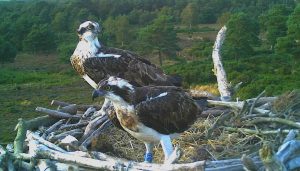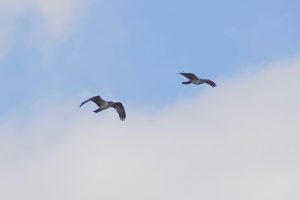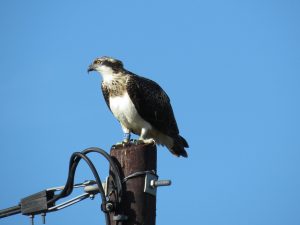We expected the first of this year’s translocated chicks to leave around a month after release and, sure enough, the first to set off, 013, headed south at 10:30am on August 30th. Chick 014 followed the next day and the remaining birds left over the course of the next three weeks. The last to depart, 002, was kept grounded for several days of wet and windy conditions, but a change of weather on September 21st was his cue to depart. After an early morning feed at the release site, the young male left a favourite perch, slowly circled to gain height and then headed off purposefully south. He was ten days later than any of the birds last year but had chosen the perfect morning to leave. It is amazing to think that by now he’s probably in southern Europe or perhaps even West Africa. Having lingered around the release site for 47 days after release, 002 would certainly have left in good condition with 3-sqaure meals per day in him! The post-fledging period – the time between their first flight and migration – is of critical importance for all young Ospreys. It helps the juvenile birds to develop confidence on the wing and also to build up strength for the long flight south. Crucially, it is also when young Ospreys imprint on their natal site, and therefore when the translocated birds learn that Poole Harbour is home.
Back in early September we also reported to you the difficulties our translocation had faced which resulted in several of this year’s birds passing away. At the time of writing, one of the birds, 005, had been taken to Cotswold Wildlife Park for treatment but, after initially making some progress, later deteriorated and also died a few weeks later. As reported at the time, tests were ongoing as we needed to make sure every part of our process was analysed properly, allowing us to get a true and full understanding as to what was happening. Our team reacted extremely fast and we left no stone un-turned during this examination. Ensuring no infection or disease was being spread across the birds was ultimately the first most important factor to be addressed. Luckily, initial tests indicated no sign of this, and we were confident our issues laid elsewhere. We had our food sources professionally analysed several times as well as our water supply and results from those tests also showed that neither were directly responsible for the deaths. Ongoing tests by the pathologists at Cotswold Water Park indicated that it looked as if a Thiamine (vitamin B1) deficiency could be main cause of death. Thiamine levels in our food supply hadn’t been analysed during the first round of tests due to the complexities of that type of analysis, so food samples had to be sent to a lab in Europe for further analysis. Tests from those samples indicated some low levels of Thiamine, however it has now been concluded that a number of underlying issues in the birds, that would not normally manifest themselves, were exacerbated by another main factor; this summer’s heat wave, which impacted on the birds’ nutritional intake and individual development. It’s no coincidence that it was the older, stronger set of birds that survived this year.
Having a clearer understanding of what happened this year now allows us to implement and plan for next year, like making sure we only select birds of a specific age or older. However, we will continue to work with an expert team of avian pathologists from the International Zoo Veterinary Group to determine any other underlying causes of these deaths. Yes, the project faced hardships this summer, however it’s easy to overlook the many positives that also developed over the course of the year, of which there were many. Firstly, this summer/autumn saw a big increase compared to last year in the amount of interaction between our translocated chicks and migrant Osprey that were passing through the harbour. The day after the first release on July 31st, two migrant Osprey spent several days visiting our freshly released youngsters at the release site, often flying down and hovering over the feeding nests. In early August, up to three migrant Osprey were then active in and around the release site, often being joined by one of our birds in the air for a few minutes.
As our birds became a bit braver and bolder they began exploring further afield and many visitors to RSPB Arne nature reserve were treated to wonderful views of 007, 008 and 014 for several weeks as they pursued and pestered fish carrying adults to, on and away from the Middlebere nesting platform.
Our youngsters also began exploring the Wareham Channel, which is Poole Harbour’s premier fishing zone for Osprey during the spring and autumn, and it was here that we witnessed two amazing sights, both whilst hosting our public bird boats. Firstly, on August 24th we received a phone call from one of our volunteers that 008 was heading towards us and, sure enough, she appeared from over the top of Arne Hill where she then spent 20 minutes practice fishing and dropping into the water like she’d been doing it for years. Secondly, on August 27th we noticed from our boat trip that one of the nesting platforms on the Arne shoreline had a migrant Osprey sat on the feeding post with a fish, but, most amazingly of all, another Osprey was poking it’s head out from within the nest itself. We contacted our volunteers who had the radio tracking equipment and they were confident it was 013. Just amazing and, even better, a guest on board managed to get a distant record photo of the event.
You may be asking why all of this is important? The reason is because when migrant Osprey are passing through the harbour, and they then encounter and engage with our youngsters, it totally changes the dynamics of how those migrant Osprey see Poole Harbour – as a productive site for nesting. This in turn will then hopefully draw migrant Osprey back to Poole Harbour to breed, as well as our translocated chicks, and that’s exactly what we saw this spring. Last year, a non-breeding, two-year old female from Rutland called CJ7 spent a week in August ‘hanging out’ with our chicks in and around the release site before migrating off south for the winter. Tim Mackrill said at the time, “I bet she comes back to Poole Harbour next spring”. She did just that. This spring, a blue-ringed Osprey was seen arriving into the harbour and after a day was tracked down so that the ring number could be read; it was CJ7 who initially spent a week feeding from a favoured perch on RSPB Arne before adopting one of the nesting platforms for a further three weeks, and was even seen sitting in it several times. This was very exciting, however, because there were no males in the area wanting to set up a territory, she sadly spent the rest of the summer on her own.
Could that be about to change this coming spring? In April and May 2019, we could start seeing some of our released birds from 2017 arriving back for the very first time. If any do, it’s unlikely they’ll breed. However, if they come back and engage with CJ7, or any other migrant Osprey that now regard Poole Harbour as a potential breeding site, then things could start getting very interesting very soon and we’ll certainly be on the look out to try and track down any colour-ringed birds next year.
Finally, we’d also like to mention the public focus and interest the project has developed. The primary focus is to establish a south coast breeding population of Osprey, but naturally this type of work will attract plenty of positive public attention and we’re already beginning to see the local benefits. In 2017 we hosted just three Osprey boat cruises to celebrate the launch of the translocation and each of the three trips sold out. This year we decided to host nine trips and yet again all of them sold out. Over those nine days we engaged and enthused with just under 500 people, many of who had never seen an Osprey before. As luck would have it, it was a great autumn for migrant Osprey and each trip saw between 3-6 migrants as well as some of our translocated birds. The team at RSPB Arne also began running early morning Osprey walks on their reserve which were well received and will hopefully become a regular feature each August and September.
So, to wrap up our 2018 season, we’d again like to thank everyone for their support, kind words, financial contributions and generosity when it came to this year’s translocation. When our team were at their lowest, you were there for us and as a thank you we promise that, despite this year’s struggles, we’ll make the Poole Harbour Osprey translocation project the success it deserves to be, so that the birds can flourish and future generations can witness nesting Osprey on the south coast once more.

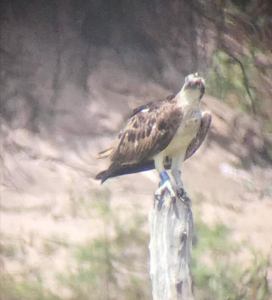
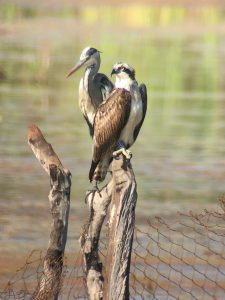 individuals. Over Christmas, we received fantastic news affirming the success of our 2019 season, which was a sighting of recently released juvenile 019 in The Gambia. This sighting was reported by Joanna Dailey who sent us some beautiful photos of 019 looking healthy and in her element at Gunjur Quarry, some 3,500 miles away (see photo). She’s now been seen there on two occasions, most recently on the 19th of January, reported by the team from the Osprey Leadership Foundation. The translocation work will start again in the summer, but before then we will have plenty to be getting on with…
individuals. Over Christmas, we received fantastic news affirming the success of our 2019 season, which was a sighting of recently released juvenile 019 in The Gambia. This sighting was reported by Joanna Dailey who sent us some beautiful photos of 019 looking healthy and in her element at Gunjur Quarry, some 3,500 miles away (see photo). She’s now been seen there on two occasions, most recently on the 19th of January, reported by the team from the Osprey Leadership Foundation. The translocation work will start again in the summer, but before then we will have plenty to be getting on with…